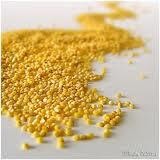The humble 'chekku ennai' or cold-pressed oil makes a comeback, but at a premium price
A friend, recently, was surprised to see a bottle of
cold-pressed sesame oil on an organic store shelf. “It’s just
old-fashioned chekku ennai!
When I was little, my sister and I used to bring back a brimming pail, from the chekku,
for just Rs.5! But now, it costs more than refined oil!” After gently
pointing out that, since she was pushing sixty, the Rs.5-a-pail was a
very-long-time-ago, we decided to find out if cold-pressed oils, with
their premium price tags (ranging, depending on the brand, from a small
to a significant price differential over regular oils) are really worth
the hype.
But first, a bit about cold-pressed oils.
Cold-pressing
is the traditional method of extracting oil from seeds/fruits. The raw
material (sesame/ peanut/ coconut/ sunflower seeds) is typically ground
into a paste, and this is pressed with a heavy stone mill, turned by
bullocks, until it expels the oil. This first-pressed oil, is sold
unrefined, and without any additives.
Nutrients intact
“Cold-pressed
oils have all their nutrients intact, retaining the natural properties
of the oil-seeds, unlike refined oil,” says Chandra Padmanabhan,
cookbook writer. “It’s a bit like atta and maida; the source is the same, but isn’t atta far superior to maida,
nutritionally?” she asks. Nimmi Ittycheria John, nutritionist and diet
consultant, says “refining degrades nutritional value, and more
significantly, introduces harmful trans fats in an attempt to improve
shelf life for commercial reasons”.
But, refined oils, produced on a large scale (the output for a commercial oil mill runs into tonnes, as opposed to a small chekku,
whose daily output can be gathered in two tins!) and backed by vigorous
media campaigns, had almost done away with traditionally extracted
oils. Except, now, as with all things organic and natural, it’s
increasingly becoming popular in urban homes.
“There
is a lot of awareness now, on cold-pressed oils. I have customers coming
from Vellore, to buy it. The supply though is limited; because, in a
day, we can only extract two tins of oil from our chekku in
Kallakurichi,” says M. N. Rajendran, owner, Annai Organic Foods. The low
yield is because the oilseeds are not heated to increase the yield, and
the oil that is expelled is cold and pure. Insisting on the importance
of cold oils, Rajendran says that the oil extracted by large-scale
mechanical presses comes out warm. “But cooking oil isn’t supposed to be
pre-heated, isn’t it,” he asks.
“We Indians sadly
only woke up to our age-old methods of oil extraction when the olive oil
lobby began trumpeting terms such as ‘cold-pressed’ and ‘extra
virgin,’” says Nimmi. Besides, sesame oil is in no way inferior to olive
oil, says Chandra. “Both are mono-unsaturated oils, and cold-pressed
sesame oil has similar health benefits. So there’s no pressing need to
substitute imported olive oil in our recipes and compromise on the taste
of South Indian food,” she reasons. “Cold-pressed sesame oil smells and
tastes especially good,” says Rajendran. “When commercially
manufactured, molasses is added to the oil, to mask its natural
bitterness; but in a chekku, we add palm sugar or jaggery, which heightens its flavour.” And oil from a chekku keeps for a year, says Rajendran, as long as it’s stored in clay utensils.
Ancient wisdom
Understanding
the importance of including more than one variety of cold-pressed oil
in the diet, South Indian menus have always incorporated three —
groundnut oil (with its high heating point) for frying, coconut oil for
dressing, and sesame oil for curries and gravies. “All the three have
their own benefits,” says Nimmi. “As much as coconut oil has received
bad press being high in saturated fatty acids, which are considered
potential artery cloggers, ironically it has medium chain fatty acids
that are seen as heart protectors. However, to err on the side of
caution, I'd advocate using these different oils (in moderation) like
they were traditionally used in different dishes to get the benefit of
each oil, especially in combination with other ingredients. For example,
in a Kerala fish curry, the combination of kokum, fenugreek, Kashmiri
chilli and oily fish might just complement a spoon of cold-pressed
coconut oil drizzled on top while serving. These areas are greatly
under-researched,” she says.
But whichever oil you
use, use it sparingly, warns Chandra. “One gram of oil has 9 calories; 1
teaspoon, therefore, has 45 calories, the equivalent of half a chapatti. Remember, the unburned calories will sit around as fat!”











